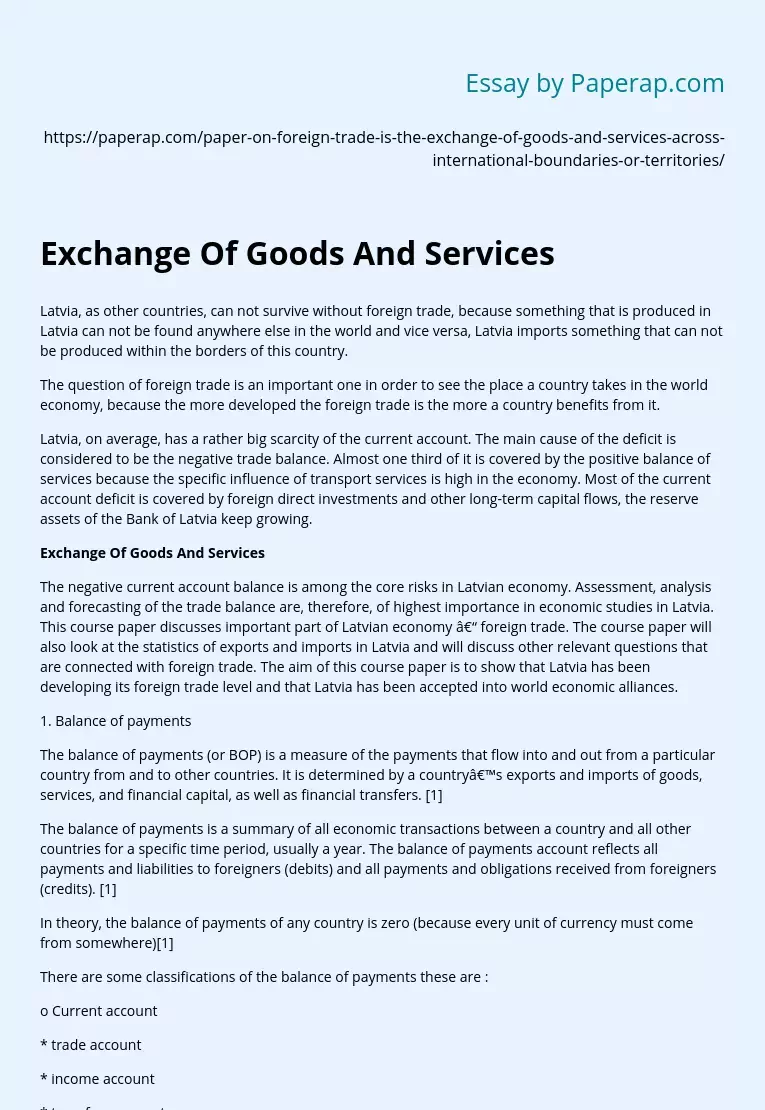Exchange Of Goods And Services
Latvia, as other countries, can not survive without foreign trade, because something that is produced in Latvia can not be found anywhere else in the world and vice versa, Latvia imports something that can not be produced within the borders of this country.
The question of foreign trade is an important one in order to see the place a country takes in the world economy, because the more developed the foreign trade is the more a country benefits from it.
Latvia, on average, has a rather big scarcity of the current account.
The main cause of the deficit is considered to be the negative trade balance. Almost one third of it is covered by the positive balance of services because the specific influence of transport services is high in the economy. Most of the current account deficit is covered by foreign direct investments and other long-term capital flows, the reserve assets of the Bank of Latvia keep growing.
Exchange Of Goods And Services
The negative current account balance is among the core risks in Latvian economy.
Assessment, analysis and forecasting of the trade balance are, therefore, of highest importance in economic studies in Latvia. This course paper discusses important part of Latvian economy – foreign trade. The course paper will also look at the statistics of exports and imports in Latvia and will discuss other relevant questions that are connected with foreign trade. The aim of this course paper is to show that Latvia has been developing its foreign trade level and that Latvia has been accepted into world economic alliances.
1. Balance of payments
The balance of payments (or BOP) is a measure of the payments that flow into and out from a particular country from and to other countries. It is determined by a country’s exports and imports of goods, services, and financial capital, as well as financial transfers. [1]
The balance of payments is a summary of all economic transactions between a country and all other countries for a specific time period, usually a year. The balance of payments account reflects all payments and liabilities to foreigners (debits) and all payments and obligations received from foreigners (credits). [1]
In theory, the balance of payments of any country is zero (because every unit of currency must come from somewhere)[1]
There are some classifications of the balance of payments these are :
o Current account
* trade account
* income account
* transfers account
o Capital account
[4]
Current account: records net flow of money into a country resulting from trade in goods and services and transfer payments made from abroad [1]
Capital account: records net flow of money from purchases and sales of assets such as stocks, bonds and land [1]
The domestic demand in Latvia is bigger than the gross domestic product, creating the deficit in the current account. This means that also foreign savings should be used to finance domestic investment. The level of savings in Latvian economy has not essentially changed and equals to approximately 20%. Investments, in contrast, grow at a more rapid rate.Thus, the lack of balance between savings and investment (deficit of the current account) is a regular phenomenon in the Latvian economy.
2. Latvian foreign trade policy
The Ministry of Economics is the main institution which implements Latvia’s interests in the field of foreign trade policy in the EU, WTO and other international institutions and organizations, carries out export promotion policy, as well as, within the framework of its competence, enforces internal market protection policy and fosters foreign economic cooperation with other countries.
Latvia’s trade relations with other countries are based on multiparty treaties within the WTO, free trade agreements (FTA) and other treaties which provide for the most-favoured nation regime (MFN).
Since its accession to the EU on May 1st, 2004, all foreign trade rules and international treaties currently in force within the EU became binding for Latvia. This created new conditions in the economic cooperation with Latvia’s neighbours and other third countries. Currently, EU internal trade constitutes approximately 80% of the foreign trade of Latvia. Trade with third countries has meanwhile seen some significant changes:
* introduction of the common EU external customs tariff, which led to import duty changes;
* expansion of the external market due to the many FTA’s concluded by the EU;
* introduction of quantitative restrictions (quotas) for imports of certain goods;
* application of market safeguard measures currently in force in the EU to imports of certain goods starting from May 1st, 2004.
Foreign trade is important for Latvia, since the internal market cannot ensure a sufficient growth for Latvian manufacturers. Only stable growth of Latvian exports can ensure the improvement of trade balance and the increase of GDP. Countries of the EU and CIS play the most important role in the foreign trade of Latvia at present, and this is not expected to change in the nearest future. However, in the light of the saturation of EU market and its poor growth rates, the importance of third countries in the foreign trade of Latvia is expected to grow. Latvian entrepreneurs face increasingly more new opportunities in such markets as USA, Russia, Ukraine, China and Japan.
Exchange Of Goods And Services. (2019, Dec 05). Retrieved from https://paperap.com/paper-on-foreign-trade-is-the-exchange-of-goods-and-services-across-international-boundaries-or-territories/

